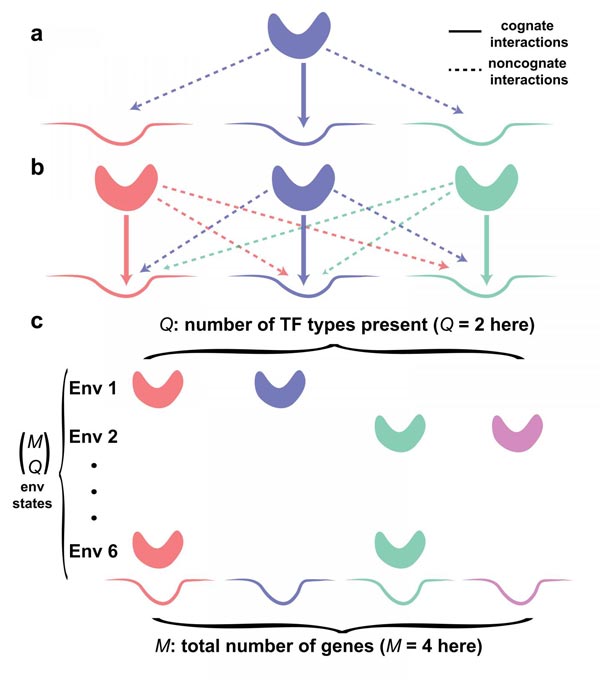Global crosstalk limits gene regulation

(a) A TF preferentially binds to its cognate binding site, but can also bind noncognate sites, potentially causing crosstalk--an erroneous activation or repression of a gene. (b) In a global setting where many TFs regulate many genes, the number of possible noncognate interactions grows quickly with the number of TFs; additionally, it may become difficult to keep TF recognition sequences sufficiently distinct from each other. (c) Cells respond to changing environments by attempting to activate subsets of their genes. In this example, the total number of genes is M = 4, and different environments (here, 6 in total) call for activation of differ- ent subsets with Q = 2 genes. To control the expression in every environment, TFs for Q required genes are present, while the TFs for the remaining M ? Q genes are absent. Because of crosstalk, TFs can bind noncognate sites, generating a pattern of gene expression that can differ from the one required. Credit: IST Austria, 2016
The specificity of this regulation originates in the binding interactions between special regulatory proteins, called transcription factors (TFs), and short regulatory sequences on the DNA, called binding sites.
Although each type of TF preferentially binds certain regulatory DNA sequences, evidence shows that this binding specificity is limited, and that TFs bind other noncognate targets, too.
If these sites happen to be regulatory elements of other genes, noncognate binding not only depletes TF molecules, but could also actively interfere with gene regulation. This suggests that the crosstalk problem is global.
In “Intrinsic limits to gene regulation by global crosstalk”, a research paper published on August 4 in Nature Communications, ISTFellow Tamar Friedlander, PhD student Roshan Prizak, and Professors Calin Guet, Nick Barton and Gasper Tkacik construct a biophysical model for crosstalk in transcriptional regulation that accounts for all cross-interactions between regulators and their binding sites.
They identify the parameters that have a major influence on crosstalk severity. While some of these parameters are difficult to estimate, they show that there exists a lower bound to crosstalk with respect to these parameters. This implies the existence of a “crosstalk floor,” which cannot be overcome even if TF concentrations were optimally adjusted by the cell and compensated for sequestration at noncognate sites.
Although most of the biophysical constraints have been understood at the level of individual genetic regulatory elements, the researchers find that crosstalk is special: while it originates locally due to biophysical limits to molecular recognition, its cumulative effect only emerges globally.
At the level of a single genetic regulatory element, crosstalk can always be avoided by increasing the concentration of cognate TFs or introducing multiple binding sites in the promoter. It is only when these same cognate TFs act as noncognate TFs for other genes, or that new binding sites in the promoter drastically increase the number of noncognate binding configurations, that crosstalk constraints become clear.
Media Contact
All latest news from the category: Life Sciences and Chemistry
Articles and reports from the Life Sciences and chemistry area deal with applied and basic research into modern biology, chemistry and human medicine.
Valuable information can be found on a range of life sciences fields including bacteriology, biochemistry, bionics, bioinformatics, biophysics, biotechnology, genetics, geobotany, human biology, marine biology, microbiology, molecular biology, cellular biology, zoology, bioinorganic chemistry, microchemistry and environmental chemistry.
Newest articles

Superradiant atoms could push the boundaries of how precisely time can be measured
Superradiant atoms can help us measure time more precisely than ever. In a new study, researchers from the University of Copenhagen present a new method for measuring the time interval,…

Ion thermoelectric conversion devices for near room temperature
The electrode sheet of the thermoelectric device consists of ionic hydrogel, which is sandwiched between the electrodes to form, and the Prussian blue on the electrode undergoes a redox reaction…

Zap Energy achieves 37-million-degree temperatures in a compact device
New publication reports record electron temperatures for a small-scale, sheared-flow-stabilized Z-pinch fusion device. In the nine decades since humans first produced fusion reactions, only a few fusion technologies have demonstrated…





















